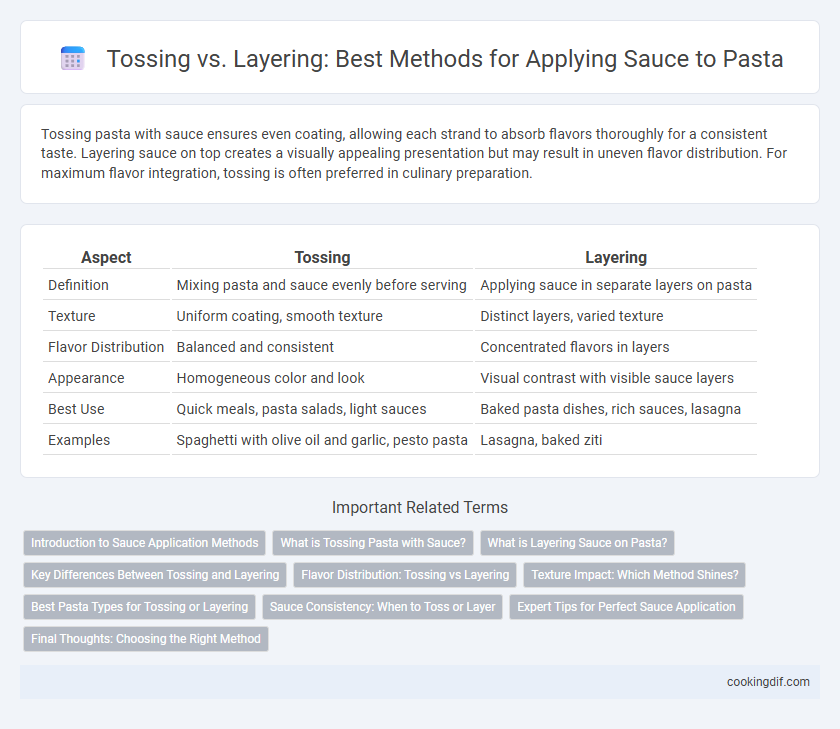Tossing pasta with sauce ensures even coating, allowing each strand to absorb flavors thoroughly for a consistent taste. Layering sauce on top creates a visually appealing presentation but may result in uneven flavor distribution. For maximum flavor integration, tossing is often preferred in culinary preparation.
Table of Comparison
| Aspect | Tossing | Layering |
|---|---|---|
| Definition | Mixing pasta and sauce evenly before serving | Applying sauce in separate layers on pasta |
| Texture | Uniform coating, smooth texture | Distinct layers, varied texture |
| Flavor Distribution | Balanced and consistent | Concentrated flavors in layers |
| Appearance | Homogeneous color and look | Visual contrast with visible sauce layers |
| Best Use | Quick meals, pasta salads, light sauces | Baked pasta dishes, rich sauces, lasagna |
| Examples | Spaghetti with olive oil and garlic, pesto pasta | Lasagna, baked ziti |
Introduction to Sauce Application Methods
Tossing pasta with sauce ensures even coating by allowing the sauce to adhere directly to each noodle, enhancing flavor consistency in every bite. Layering involves placing sauce between pasta layers, often used in baked dishes like lasagna to create distinct flavor strata. Choosing the right method affects texture and taste, making understanding sauce application crucial in pasta preparation.
What is Tossing Pasta with Sauce?
Tossing pasta with sauce involves combining cooked pasta and sauce in a pan or bowl to ensure an even coating on every strand or piece. This method enhances flavor absorption as the heat from the pasta helps the sauce cling better, creating a harmonious dish. Tossing also allows for better integration of added ingredients like herbs, cheese, or vegetables, making each bite consistently flavorful.
What is Layering Sauce on Pasta?
Layering sauce on pasta involves placing cooked pasta in a dish and then adding sauce on top in distinct layers, allowing each component to retain its separate flavor and texture. This technique is often used in baked pasta dishes where the sauce melds with the pasta during cooking, creating a rich, cohesive bite. Layering enhances the visual appeal and offers varied flavor concentrations compared to tossing, which fully coats the pasta before serving.
Key Differences Between Tossing and Layering
Tossing pasta involves thoroughly mixing cooked pasta with sauce, ensuring even coating and flavor distribution across every strand. Layering, on the other hand, consists of alternating pasta, sauce, and other ingredients in a dish to create distinct flavor and texture layers, commonly used in baked recipes like lasagna. The key difference lies in uniform sauce integration with tossing versus structural and textural contrast achieved through layering.
Flavor Distribution: Tossing vs Layering
Tossing pasta with sauce ensures even flavor distribution by coating each strand uniformly, enhancing every bite with consistent taste and texture. Layering sauce on top can create pockets of intense flavor but often results in uneven seasoning and less integrated taste. For optimal flavor balance, tossing helps blend the sauce and pasta thoroughly, allowing the sauce to penetrate and cling to every piece.
Texture Impact: Which Method Shines?
Tossing pasta with sauce ensures even coating, resulting in a smooth and cohesive texture where every strand is flavorful. Layering sauce, on the other hand, creates distinct layers that offer varied textures, combining saucy portions with drier pasta bites. For a consistently velvety mouthfeel, tossing shines, while layering excels in delivering textural contrast.
Best Pasta Types for Tossing or Layering
Tossing pasta with sauce works best with shapes like spaghetti, fettuccine, and linguine, as their long strands evenly coat and absorb lighter sauces such as marinara or pesto. Layering sauces is ideal for sturdier pasta types like lasagna sheets or rigatoni, which hold up well under thick, baked sauces and cheese, creating rich, multi-layered dishes. Penne and fusilli are versatile and can be used for both tossing and layering due to their tubular or spiral shapes that trap sauce efficiently.
Sauce Consistency: When to Toss or Layer
Tossing pasta with sauce ensures even coating by allowing the sauce to cling uniformly, ideal for thinner, more fluid sauces such as olive oil-based or light tomato sauces. Layering sauce works better with thicker, chunkier sauces like ragu or Alfredo, where the pasta acts as a base and the sauce is added on top to preserve texture and distinct flavors. Understanding sauce consistency is key: use tossing for smooth, velvety sauces and layering to highlight hearty, robust sauces.
Expert Tips for Perfect Sauce Application
Tossing pasta with sauce ensures even coating by allowing every strand to absorb flavors uniformly, enhancing texture and taste. Layering sauce on top can create inconsistent flavor distribution, often leaving some bites dry or overly sauced. Expert chefs recommend tossing pasta in the sauce over low heat, using reserved pasta water to adjust consistency and promote better sauce adhesion.
Final Thoughts: Choosing the Right Method
Tossing pasta with sauce ensures even coating and enhanced flavor integration, making each bite consistently flavorful. Layering allows for distinct texture contrasts, ideal for baked pasta dishes where sauce accumulates between layers. Selecting the right method depends on the desired dish characteristics, balancing uniformity and texture complexity.
Tossing vs layering for sauce application Infographic

 cookingdif.com
cookingdif.com